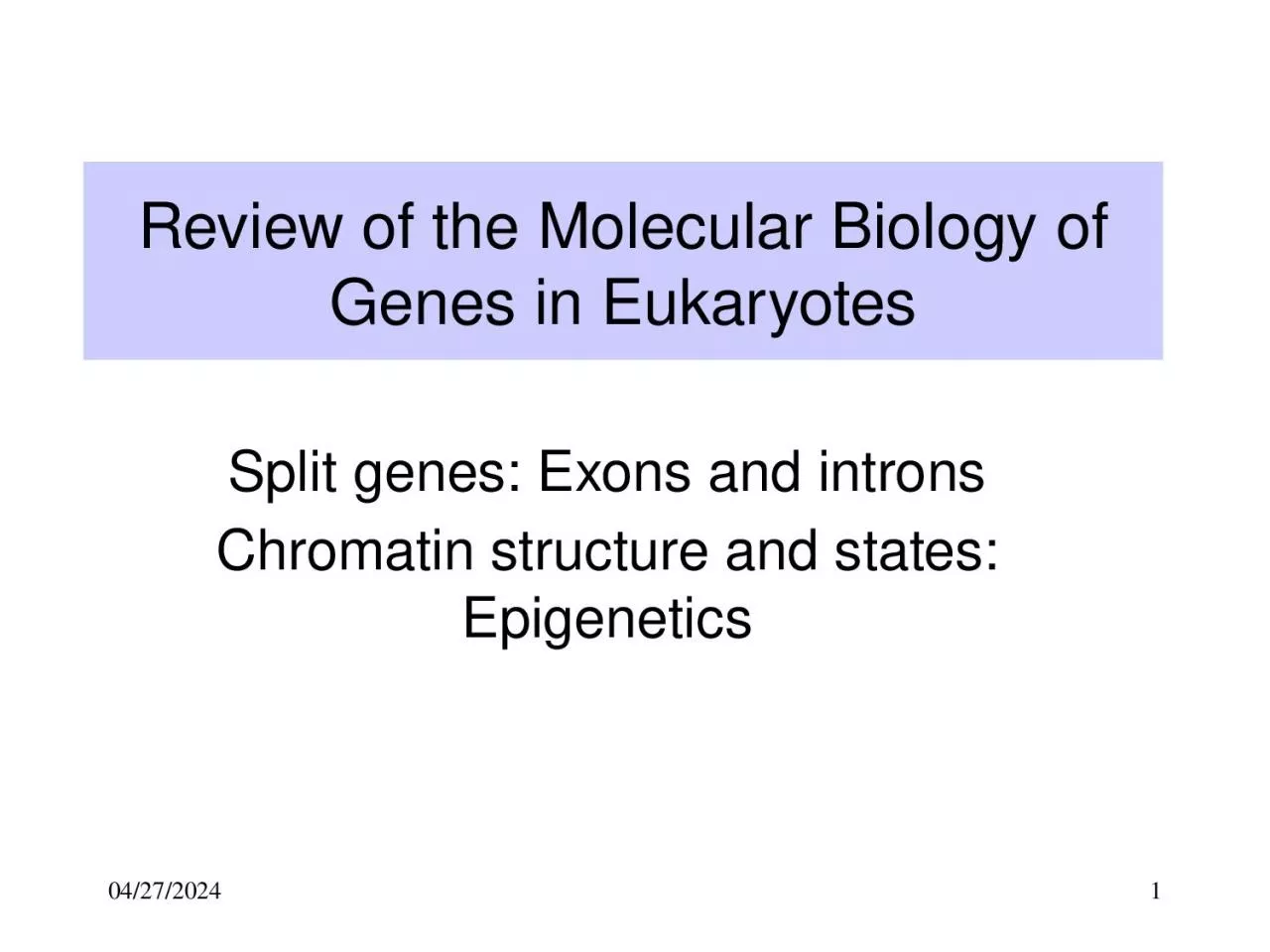

Split genes Exons and introns Chromatin structure and states Epigenetics 122114 1 Classification by nucleus Prokaryotes Organisms whose cells lack a nucleus Bacteria and Archaea ID: 915385
Download Presentation The PPT/PDF document "Review of the Molecular Biology of Genes..." is the property of its rightful owner. Permission is granted to download and print the materials on this web site for personal, non-commercial use only, and to display it on your personal computer provided you do not modify the materials and that you retain all copyright notices contained in the materials. By downloading content from our website, you accept the terms of this agreement.
Slide1
Review of the Molecular Biology of Genes in Eukaryotes
Split genes: Exons and intronsChromatin structure and states: Epigenetics
12/21/14
1
Slide2Classification by +/- nucleus
Prokaryotes: Organisms whose cells lack a nucleusBacteria and ArchaeaStill have genomic DNA, but not in a specialized organelleEukaryotes: Organisms whose cells contain a nucleus
Protists, fungi, plants, animals, …
12/21/14
2
Slide3Split genes and introns
The mRNA-coding portion of a gene can be split by DNA sequences that do not encode mature mRNAExons are the segments of a gene that code for mRNA, introns are
the segments of genes that do not encode mRNA.Introns are found in most genes in eukaryotes, also some in
Archaea
12/21/14
3
Slide4R-loops can reveal introns
12/21/14
4
5’
5’
5’
5’
Slide5Examples of R-loops in mammalian hemoglobin genes
12/21/14
5
Slide6Types of exons
5
’
3
’
Start
Stop
Transcription start
Translation
Stop
polyA
5
’
untranslated
region
3
’
untranslated
region
5
’
3
’
Protein
coding
region
promoter
GT
AG
GT
AG
GT
AG
GT
AG
Open reading frame
Gene
mRNA
Translation
Initial exon
Internal exon
Internal coding exon
Terminal exon
12/21/14
6
Slide7Human DMD
gene
7
12/21/14
Slide8Introns are removed by splicing RNA precursors
12/21/14
8
5’
5’
5’
Slide9Alternative splicing can generate multiple polypeptides from a single gene
12/21/14
9
Slide10Alternative splicing can generate multiple polypeptides from a single gene, part 2
12/21/14
10
Slide11Chromosomes and chromatin
12/21/14
11
Slide12Chromosomes organize genes inside cells and enable their expression
Bind packaging proteins to DNA to make it more compact.Histones +DNA = chromatin in eukaryotes
Virion proteins in virusesDynamic, covalent modifications of histones are associated with active portions of chromosomes
Transcription
Regulation
Replication
12/21/14
12
Slide13Bands and specialized regions of human chromosomes
Human chromosome 11:
125 Mb, 180
cM
12/21/14
13
Slide14Human chromosomes, ideograms
Mitotic chromosomes are spread and stained with Geimsa. Those that stain are shown in black.
G-bands (more A+T rich).
12/21/14
14
Slide15Human chromosomes, spectral karyotype
Reagents specific to each chromosome.
Chromosome
painting.
12/21/14
15
Slide16Chromatin states in interphase nuclei
Adapted from
Makova and Hardison (2015) Nature Reviews Genetics
12/21/14
16
Slide17Nucleosome core structure, 3D
146 bp duplex DNA wrapped around 8 histones molecules:
2 each of the dimers
H2A
-
H2B
,
H3
-
H4
N-terminal tails of histones emerge from the core
Luger et al. (1997) Nature 389: 251, Richmond lab
12/21/14
17
Slide18Principal proteins in chromatin are histones
H3 and H4 : Arg rich, mostly conserved sequence
H2A and H2B : Slightly Lys rich, fairly conserved
H1 : very Lys rich, most variable in sequence
between species
12/21/14
18
Slide19Histone structure and function
12/21/14
19
Slide20Histone interactions via the histone fold
12/21/1420
Slide21Nucleosome core structure, 3D
146 bp duplex DNA wrapped around 8 histones molecules:
2 each of the dimers
H2A
-
H2B
,
H3
-
H4
N-terminal tails of histones emerge from the core
Luger et al. (1997) Nature 389: 251, Richmond lab
12/21/14
21
Slide22Simplified view of nucleosomes
Linker: Sensitive to
micrococcal nuclease
12/21/14
22
Slide23Alterations to chromatin structure are key steps in regulation
12/21/14
23
Slide24Phosphorylation of histones
12/21/14
24
Slide25Acetylation and Deacetylation of lysines in proteins
12/21/14
25
Slide26Acetylation and d
eacetylation of histones
Co-activator EP300 is a HAT
12/21/14
26
Slide27Epigenetic features
12/21/1427
Slide28Chromatin states in interphase nuclei
Adapted from
Makova and Hardison (2015) Nature Reviews Genetics
12/21/14
28